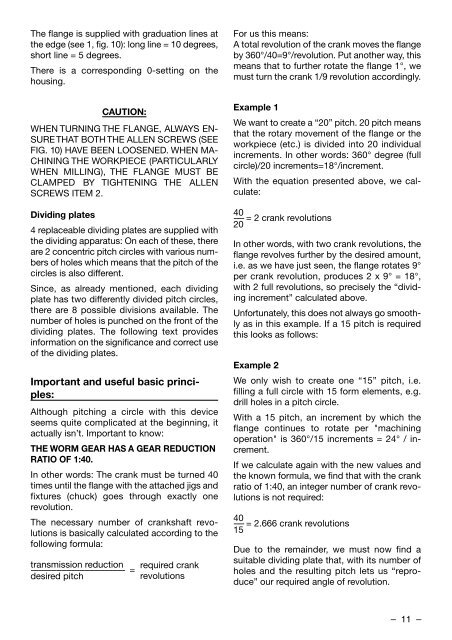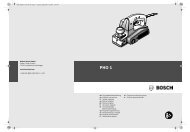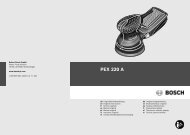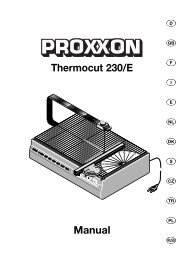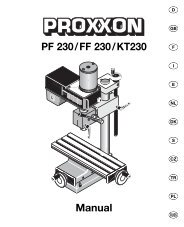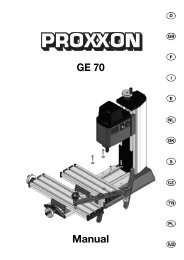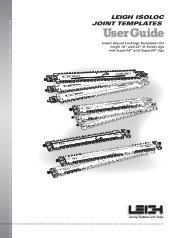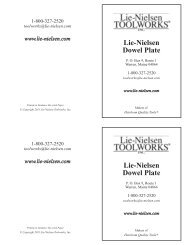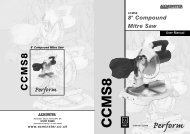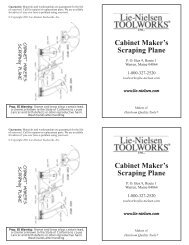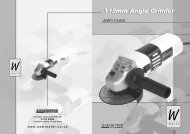Teilapparat UT 400 Manual
Teilapparat UT 400 Manual
Teilapparat UT 400 Manual
You also want an ePaper? Increase the reach of your titles
YUMPU automatically turns print PDFs into web optimized ePapers that Google loves.
The flange is supplied with graduation lines at<br />
the edge (see 1, fig. 10): long line = 10 degrees,<br />
short line = 5 degrees.<br />
There is a corresponding 0-setting on the<br />
housing.<br />
CA<strong>UT</strong>ION:<br />
WHEN TURNING THE FLANGE, ALWAYS EN-<br />
SURE THAT BOTH THE ALLEN SCREWS (SEE<br />
FIG. 10) HAVE BEEN LOOSENED. WHEN MA-<br />
CHINING THE WORKPIECE (PARTICULARLY<br />
WHEN MILLING), THE FLANGE MUST BE<br />
CLAMPED BY TIGHTENING THE ALLEN<br />
SCREWS ITEM 2.<br />
Dividing plates<br />
4 replaceable dividing plates are supplied with<br />
the dividing apparatus: On each of these, there<br />
are 2 concentric pitch circles with various numbers<br />
of holes which means that the pitch of the<br />
circles is also different.<br />
Since, as already mentioned, each dividing<br />
plate has two differently divided pitch circles,<br />
there are 8 possible divisions available. The<br />
number of holes is punched on the front of the<br />
dividing plates. The following text provides<br />
information on the significance and correct use<br />
of the dividing plates.<br />
Important and useful basic principles:<br />
Although pitching a circle with this device<br />
seems quite complicated at the beginning, it<br />
actually isn’t. Important to know:<br />
THE WORM GEAR HAS A GEAR REDUCTION<br />
RATIO OF 1:40.<br />
In other words: The crank must be turned 40<br />
times until the flange with the attached jigs and<br />
fixtures (chuck) goes through exactly one<br />
revolution.<br />
The necessary number of crankshaft revo -<br />
lutions is basically calculated according to the<br />
following formula:<br />
transmission reduction<br />
------------------------------------- =<br />
desired pitch<br />
required crank<br />
revolutions<br />
For us this means:<br />
A total revolution of the crank moves the flange<br />
by 360°/40=9°/revolution. Put another way, this<br />
means that to further rotate the flange 1°, we<br />
must turn the crank 1/9 revolution accordingly.<br />
Example 1<br />
We want to create a “20” pitch. 20 pitch means<br />
that the rotary movement of the flange or the<br />
workpiece (etc.) is divided into 20 individual<br />
increments. In other words: 360° degree (full<br />
circle)/20 increments=18°/increment.<br />
With the equation presented above, we cal -<br />
culate:<br />
40<br />
---- = 2 crank revolutions<br />
20<br />
In other words, with two crank revolutions, the<br />
flange revolves further by the desired amount,<br />
i.e. as we have just seen, the flange rotates 9°<br />
per crank revolution, produces 2 x 9° = 18°,<br />
with 2 full revolutions, so precisely the “dividing<br />
increment” calculated above.<br />
Unfortunately, this does not always go smoothly<br />
as in this example. If a 15 pitch is required<br />
this looks as follows:<br />
Example 2<br />
We only wish to create one “15” pitch, i.e.<br />
filling a full circle with 15 form elements, e.g.<br />
drill holes in a pitch circle.<br />
With a 15 pitch, an increment by which the<br />
flange continues to rotate per "machining<br />
operation" is 360°/15 increments = 24° / in -<br />
crement.<br />
If we calculate again with the new values and<br />
the known formula, we find that with the crank<br />
ratio of 1:40, an integer number of crank revolutions<br />
is not required:<br />
40<br />
---- = 2.666 crank revolutions<br />
15<br />
Due to the remainder, we must now find a<br />
suitable dividing plate that, with its number of<br />
holes and the resulting pitch lets us “repro -<br />
duce” our required angle of revolution.<br />
– 11 –


